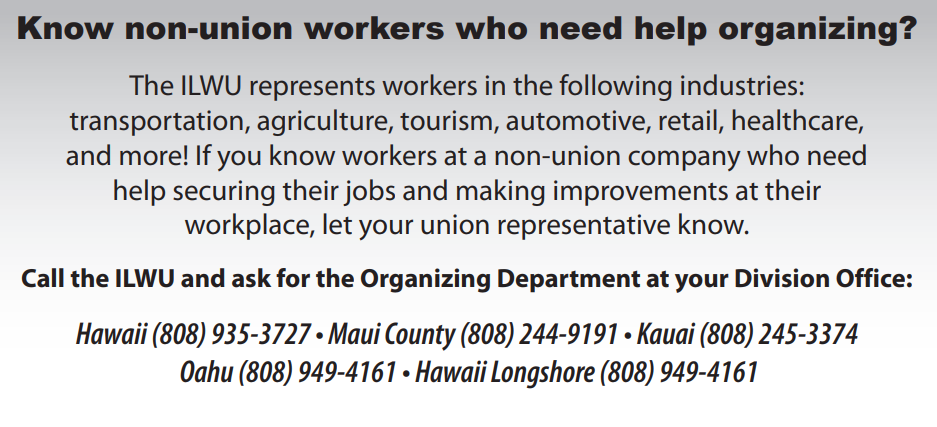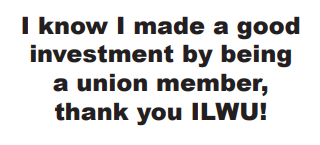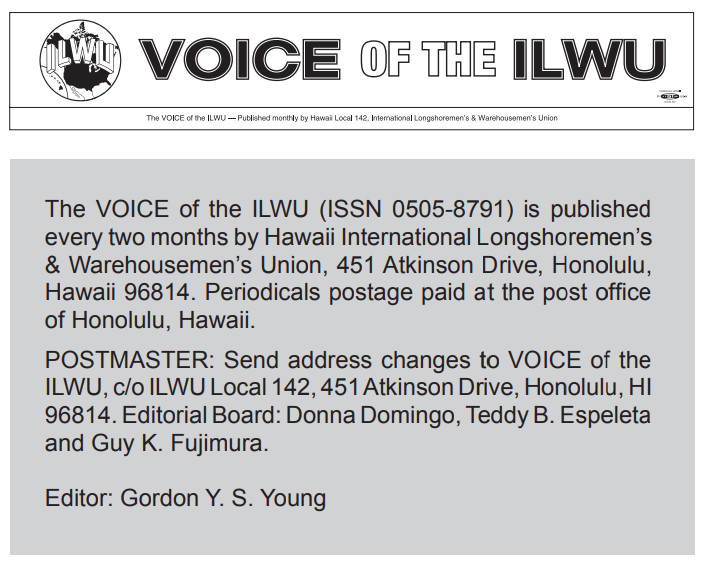House Bill 634—also known as the “worker retention” bill—was held in Conference Committee this past legislative session. Although it did not pass this year, the bill is still alive and can be revisited in the 2014 session. The ILWU will again push for passage of the bill because “worker retention” is good for the community, good for workers, and good for business.
Presently, state and federal laws provide no protection for dislocated workers, other than giving notice that their jobs may be terminated. Hawaii’s Dislocated Workers Act and the federal Worker Adjustment and Retraining Notification (WARN) Act are these two laws. In a unionized workplace, the union protects the worker. With no union, the workers are at the mercy of the new management. In the following cases, workers had unions and were able to fight for severance, extended medical, and in some cases, hiring preference. Some other examples are the Holiday Inn Airport, Naniloa Hotel, Ilikai Hotel, Schuman Carriage, Pacific Beach Hotel, and Tesoro Refinery.
The Honolulu Advertiser
In 2010, Oahu Publications, Inc., (OPI) a subsidiary of Black Press Ltd., purchased The Honolulu Advertiser (THA) and related assets. They promptly terminated all 500 workers. To avoid potential violations to antitrust laws, David Black, principal owner of Black Press, Ltd., the owner of the Honolulu Star-Bulletin hired HA Management Inc., (HAMI) to run THA until the consolidation of the two papers was complete. HAMI forced the workers to reapply for their jobs. HAMI rehired close to 450 of the terminated THA workers at more than a 10% wage reduction. When the consolidation was complete, HAMI terminated their entire workforce. The new newspaper, The Honolulu Star- Advertiser (THSA) rehired 122 workers out of 200 workers represented by the ILWU that were employed by THA.
The Honolulu Star-Advertiser recognized the ILWU because the majority of the unionized workers were retained. Those that were not rehired were entitled to severance pay, a benefit negotiated in nearly every ILWU unionized workplace. (See related editorial “I Know I Made a Good Investment” below.)
But, THA argued that since OPI purchased THA and related assets, OPI should be obligated to pay the severance because OPI is the entity that is doing the lay-off. OPI argued that they purchased THA and related assets, but not the CBA, therefore, THA should pay the severance.
The ILWU filed numerous grievances and lawsuits to clear up the legal dispute that THA and OPI had over “Who is responsible for paying the severance?” After fourteen months, the ILWU won and the severance checks were distributed to those workers not rehired.
Grand Wailea Resort Hotel & Spa
In November 1998, KSL Recreation Corp. (KSL) purchased Grand Wailea Resort Hotel & Spa and promptly terminated over 1,200 workers. The ILWU and the Grand Wailea workers mobilized the workers and the community. They lobbied their elected officials gaining full support from Maui Mayor James “Kimo” Apana and Governor Ben Cayetano. Despite pressure from the community, KSL refused to retain the workers and forced them to reapply for their jobs.
KSL rehired many of the former workers, but for different jobs and different job status. Full-time workers who needed full-time status were hired as casual “on-call” workers. Casual workers, who didn’t need full-time status, were hired for 35 hours or more. KSL also decreased wages and benefits to a level that was far below the standards of other ILWU unionized Maui hotels. The union’s campaign for a fair contract took almost fifteen months, but paid off when KSL agreed to wages and benefits that were in line with the ILWU unionized hotels.
Conclusion
When a new owner takes over a business, all too often the current workers are the first to go. Worker retention laws have been adopted in several cities on the mainland as a means to ensure a stable workforce of experienced workers within their respective industries. A stable workforce of experienced workers is critical during the transitional period accompanying a change in ownership, control or the operation of companies. A worker retention ordinance would provide existing workers a chance to prove their worth to the new owner and likely reduce the amount of unemployment caused by the transition.
These laws ensure the welfare of the working families and the communities they serve by retaining experienced workers with the knowledge of proper health and safety regulations, expertise in their trade and the understanding of the needs of the business’ customers. Managerial, supervisory and professional employees are usually exempted from worker retention laws.
Worker retention laws must be enacted to ensure the welfare of working families and the communities they serve. The ILWU has been working for many years to pass some form of Worker Retention. ILWU Local 142—and the legislators that we help to elect—will continue to work hard in the 2014 legislative session to get it done.

Editorial: I know I made a good investment
From a workforce of 200 workers, a total of 122 former members of Unit 4406 - The Honolulu Advertiser were rehired by the new employer The Honolulu Star Advertiser.
I was one of the 78 workers who were not rehired. Though I received several “60-day notice of layoff” as required under Hawaii’s Dislocated Workers Act and the federal Worker Adjustment and Retraining Notification (WARN) Act, the reality didn’t really set in until the following day of the official date of the lay-off, July 5, 2010. I woke up wondering, what am I supposed to do? The feeling was different from a day-off or the last day of a vacation because at the end of the day, I know I have to get ready for work the next day. That day is not coming tomorrow or the next—because I no longer had a job.
I applied for unemployment insurance benefits the day that I was eligible. The amount that I was projected to receive the following week was less than 50% of my normal weekly gross pay. Though it was a drastic reduction in pay, I felt fortunate because the ILWU negotiated severance pay in our Collective Bargaining Agreement (CBA). This is a benefit that most non-union workplaces don’t have. The ILWU severance benefit not only covered all regular full-time workers, but was able to cover the part-time workers, at a reduced rate.

The CBA provided for one week’s pay for each completed year of service. Having worked 33 years, I was entitled to close to $40K. But, Gannett Pacific Corporation dba The Honolulu Advertiser (THA) argued that since Oahu Publications, Inc. (OPI), purchased THA and related assets, OPI should be obligated to pay the severance because OPI is the entity that is doing the lay-off. OPI argued that they purchased THA and related assets, but not the CBA, therefore, THA should pay the severance.
I went over my past federal income tax returns to calculate the amount of dues that I paid for union membership. Generally, your employer will withhold your union dues from your pay; therefore, your pay stubs provide proof that you paid your dues. Over the 33 years that I was employed by THA, I paid a total of $16,335 for 33 years of union membership. I waited fourteen long months for my severance pay, a benefit negotiated in nearly every CBA at an ILWU unionized workplace. It took fourteen months to clear up the legal dispute that THA and OPI had over “Who is responsible for paying the severance?” The ILWU filed numerous grievances and lawsuits on our behalf at no cost to us. When ILWU won the case and the severance checks were finally handed out, I received $39,699.

In summary, I paid $16,335 for 33 years of union membership. The ILWU negotiated severance pay, a benefit in nearly every CBA negotiated by the ILWU. The ILWU paid the legal fees even after I lost my job and fought to resolve the “Who is responsible for paying the severance?” issue and I got a severance check for $39,699. This does not even count the $30,000 in pay raises the ILWU negotiated for us over 33 years, the $6,000 of vacation pay (25 vacation days, the average nonunion worker gets 10 days a year), the $4,000 of sick leave pay (15 days, non-union workers get none), the $100,000 of medical benefits, pension benefits, and the priceless benefits of having a say on the job and self-respect as a unionized worker. That works out to almost a 1,000% return on investment. I know I made a good investment by being a union member, thank you ILWU!

